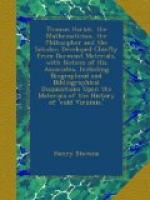In 1595 Hariot was mentioned as a distinguished man of science in his Seaman’s Secrets by Captain John Davis the navigator, a friend and partner of Raleigh.
On the eleventh of July 1596 Hariot under peculiar circumstances wrote a long and confidential letter to Sir Robert Cecil, Chief Secretary of State, in the interests of Raleigh’s Guiana projects. The letter is here given in full, as it shows better than anything else the close and confidential relations existing between Sir Walter and Hariot at that time. Raleigh had returned from Guiana, his first El Dorado expedition, in August 1595, and had in the mean time employed such energy and enterprise that within about five months he had fitted out and dispatched his second El Dorado fleet under his friend Captain Keymis. This second expedition returned to Plymouth in June 1596, a few days after Raleigh had gone with Essex and Howard of Effingham on that world-renowned expedition against Cadiz. Sir Walter appears to have left his affairs in the hands of his ever faithful Hariot, and hence this sensible and timely letter in the absence of his patron. There appears to have been no complaint against Keymis; but the master of his ship, Samuel Mace, seems to have been less discreet. The letter tells its own story, and gives a vivid picture of the intelligent earnestness of Sir Walter respecting Guiana, and at the same time the earnest intelligence of Hariot during Raleigh’s absence in Spain.
It has been denied that Raleigh really expected to find the El Dorado in either his first expedition of 1595 or last in 1617, but this letter goes to show that both he and Hariot had firm faith in the scheme. Indeed in a German book of travels just published, entitled ’ Aus den Llanos. Schildenung einer naturwisscn-schaftlichen Reise nach Venezuela, Von Carl Sachs, Leipzig, 1879,’ the writer states that the export of gold from Spanish Guiana in 1875 was 79,496 ounces. He says that the richest mine, that of Callao, has of late years returned as much as 500 per centum. After briefly narrating the expeditions of Raleigh, which had been preceded by various Spanish expeditions, he adds: ’Now at this day, after nearly three centuries, the riches sought for have been actually found In the very country where these unfortunate efforts were made.’ Hariot’s letter is as follows:




